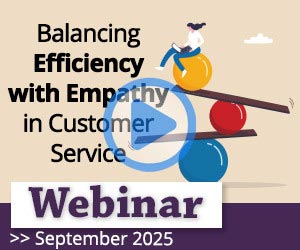We asked our panel of experts for practical de-escalation techniques contact centre agents can use when dealing with a challenging customer to defuse the situation and find a suitable resolution.
Let Them Speak

No matter how great your service, there are times things go wrong, and allowing a customer to unburden or vent, so long as it is not abusive, can be very cathartic.
It’s potentially also just adding insult to injury to interrupt a customer while they explain their view of the situation.
The simple release of emotional build-up and tension itself can be a big contributor to an interaction that ends in a positive way. Even if there is nothing that can be done, giving customers the space to have their say is an act of acknowledgement.
Contributed by: Stuart Clarke at Odigo
Listen Closely
There’s perhaps no better de-escalation technique than simply lending an ear. If you talk more than the customer, it communicates that you care more about a quick resolution than a correct one.
When you’re dealing with an angry customer, do much more listening than speaking.
It’s not enough to stop talking while the customer vents their frustration, though. The best way to de-escalate is by practising active listening.
Ask open-ended questions to invite detailed responses, acknowledge and validate their frustrations, and repeat their responses back to them in your own words to be sure you understand them accurately.
These simple techniques demonstrate that you care about their predicament and want to understand it thoroughly before you attempt to come up with a solution.
Contributed by: Cyara
Wait for the Customer to Take a Breath

Giving customers the space to vent, to get negative emotions off their chest, is service 101. If an agent jumps in too soon, they run the risk of becoming the subject of the customer’s barrage. Yet, when the customer continues for minutes, agents can feel they’re losing control of the conversation.
It’s a tricky balance, as agents do not want to interrupt, but want to help.
Instead, they should stay focused on the customer, engage in active listening and wait until they take a breath.
That is the perfect opportunity to step in and provide support. Once in control, acknowledge what the customer has said and redirect them to the next steps.
Acknowledgement and empathy are critical.
The customer must feel listened to and heard. As such, the following statement may work wonders: “Absolutely, as you say, it sounds ‘difficult’. What I recommend we do is…”
Contributed by: Graeme Meikle at Calabrio
Stay Calm
Emotions have a powerful effect on the brain. In many cases, this can be good, such as when it leads you to flee from serious danger.
In conflict, however, emotions can be dangerous. If you get angry enough, it leads to what’s called the “amygdala hijack”.
Rational responses go out the door, and your body goes into fight-or-flight mode. That’s not a good recipe for de-escalating a difficult customer interaction.
Instead, your role as an agent is to stay calm and try to help the customer calm down with you. That’s easier said than done, but start by remembering that the customer’s frustration isn’t personal.
They’re upset about a product or a bad experience with the company, not with you as a person. When you remember that and respond calmly and rationally to an angry tirade, it can be disarming.
Contributed by: Cyara
Be Human and Honest

Some organizations try to train advisors on how to handle every type of interaction with customers and give them the tools to handle the difficult situations.
While this is important, unfortunately, it isn’t a “one size fits all” approach and your team members need to have the skills to be able to handle any situation that may arise.
Advisors need to listen to what is being said and, just as importantly, how it is being said. They should consider the customer’s tone and the words they are using to be able to put themselves in their shoes. Once they have mentally done this, it is their opportunity to shine.
Advisors should think about what they want to say and how this may be perceived by the customer, be honest, don’t over-promise and always give the customer the opportunity to respond.
Each time the customer’s tone changes, the team member should review what they are saying and how to respond appropriately.
Ultimately, being human and honest is the best way to de-escalate a situation.
Contributed by: Drew Naylor at MaxContact.
Show Empathy
This needs to be sincere and timed right. If agents don’t listen to everything the customer has to say, empathy can seem disingenuous because they didn’t wait to hear the full story.
Active listening facilitates understanding, which informs the best possible resolution. Remember it’s cognitive empathy and empathetic action that are needed; emotional empathy is exhausting and undesirable.
A degree of detachment is a must for resilience, like remembering it’s not about you when dealing with an enraged customer.
Although a great deal is said about customer connection, it’s never the goal, it is the pathway to resolution or the happy by-product of a job well done.
Contributed by: Stuart Clarke at Odigo
Show You Care

As you are not in a face-to-face environment where body language and facial expressions are visible, it’s vital that advisors listen to customers’ concerns and acknowledge each point that’s made.
Repeat back and break down those concerns as appropriate, especially if they are complex, to add to that validation.
Staying calm and remaining objective can also help calm a situation whilst advisors establish root causes and identify solutions.
Verbal nods can be highly beneficial, and avoid putting customers on hold if at all possible as this may cause further frustration.
Always try and acknowledge the situation and how it’s made the customer feel, apologizing as appropriate, even if that doesn’t mean recognizing that there is an issue.
Offering understanding/sympathy and validating frustrations helps convince customers that they’re being listened to and supported.
And don’t over-promise. It may be that you need to escalate (for example if a solution needs further authorization) but explain this is the case and give realistic timescales and routes to follow up.
Contributed by: Kathryn Cattell at Sensée
Offer a Real-Time Helping Hand

A contact centre can be a stressful and overwhelming environment for agents. Customers often call up annoyed, irritated, and sometimes aggressive. Agents are expected to be able to resolve these issues quickly before conflict occurs.
Organizations that do best in these situations are those with effective strategies and tools in place, and with trained agents who are able to defuse tension and turn difficult interactions into opportunities.
Through the use of technology that can monitor customer interactions and analyse sentiment, organizations can deliver real-time agent guidance for next-best actions, such as when it might be time to escalate to a supervisor, providing that extra ‘helping hand’ or back stop when the pressure is on.
By providing agents with real-time alerts that can help direct behaviour and influence the outcome of an interaction while it’s still happening, organizations can achieve more than just improved first call resolution metrics – they can turn frustrated, dissatisfied customers into happy, loyal ones.
Contributed by: Frank Sherlock at CallMiner
Manage Customer Expectations
The disconnection between expectations and delivery is often what angers customers in the first place.
Managing expectations and setting the stage for what can and cannot be accomplished is key to understanding and de-escalating; if you don’t, your customers may feel the need to further escalate.
Use Three Closed-Ended Questions Back-to-Back
Closed-ended questions can be answered in one word. When used in customer service, agents limit what the customer says to them, avoiding another aggressive flare-up.
Indeed, if an agent strings together three closed questions, they can gain control over the conversation.
Of course, it won’t always work. But to give it the best chance, questions should require the customer to recall or look up information.
Why? Because it moves the customer’s thinking from the emotional right side of the brain to the more rational left side.
As an example of this, consider these three questions:
- What is your order number?
- What date did you make the order?
- Could you read me the code on the top-right of your confirmation email?
Each is relevant to helping the customer and requires them to use the left side of their brain to find the answers – limiting their emotional response.
Contributed by: Graeme Meikle at Calabrio
Make Proactive Promises
Promises are promises, not a tactic to buy time, and technology can really help to keep to them. There is no reason why a callback can’t be arranged straight away, or an SMS or email confirming the next steps sent as an immediate follow-up.
Customers can even be involved in deciding their resolution process. Are they happy to wait two days and speak to the same agent or would they prefer a quicker callback?
If there’s a delay to a planned resolution, be transparent and keep the momentum going by keeping customers proactively informed, making the most of preferred contact channels.
Contributed by: Stuart Clarke at Odigo
Four Key Techniques

With the long-term satisfaction of your customers at stake, it’s essential that agents know how to quickly de-escalate emotionally heightened situations.
Here are some of the most effective techniques to use.
Active listening: Rather than interrupting or plotting your next suggestion, stop and listen to what the caller is really saying. The caller will feel heard and that their problem has been acknowledged.
Don’t say ‘no’: Callers hate to hear ‘I can’t’ or ‘that’s not possible’. Instead, try ‘I will look into that’ or ‘I will loop in the right person/team for that’, but remember to always be honest.
Mirror their complaint: Repeat the caller’s description of their issue. This helps ensure you have heard them correctly and gives them confidence that you understood their problem.
Script responses: To avoid improvising, have some pre-prepared de-escalation phrases to hand and deliver them in a confident, empathetic, calm tone.
Contributed by: Caroline Leonard at Spearline
The Power of Advocation

Now that you’ve listened, set expectations, and communicated with the customer, you can begin to work as an agent of happiness.
If you’ve built trust through listening and communication, you can now operate as an advocate for the customer.
And while most customers can’t tell you what they want or what will make them happy, an agent who is adequately trained and confident in their ability to advocate for a customer can now make recommendations and get back to the essentials of call centre customer service in order to achieve the desired customer journey and outcome.
By using these techniques, contact centre agents can provide their organizations with an invaluable opportunity to cement the customer relationship and optimize connection to the brand when dealing with challenging customers.
Ensuring thoughtful listening, management of customer expectations, proactive communication and seamless consistency in messaging will defuse situations and support resolution for demanding customers, providing the architecture for a successful customer de-escalation strategy.
Contributed by: Bruce Skjolde at Alvaria
Offer Compensation
If you have an angry customer on the line, your goal should always be to turn a difficult situation into a new opportunity.
New research shows that 64% of customers leave for a competitor after a poor experience, so this is your chance to steer the train back onto the track and keep that from happening.
Once you’ve calmed the situation and shown the customer you truly want to listen and understand their problem, it’s never a bad idea to offer some form of recompense for their troubles.
That might be a discount code for a future purchase, a refund, or some other way to apologize and show your appreciation.
The right option will depend on the circumstances. Whatever it is, though, don’t end the interaction without offering the customer some concrete acknowledgement of their troubles – and recognition of their value to your business.
Contributed by: Cyara
Dig Up Your Own Examples!
Dealing with emotional customers day after day, agents often develop their own methods of de-escalation. Pinpointing those that have the best influence on sentiment is a worthwhile exercise.
However, spotting the best is sometimes tricky, with manual call listening initiatives only skimming the surface of contact centre conversations.
Quality management solutions can help here. They measure sentiment throughout each interaction, so operations can dig into examples where sentiment swings significantly from negative to positive.
If particular agents are good at turning calls around, delve into their conversations, pick out trends and speak to them about their winning techniques.
This way, the contact centre can show recognition of good performance and harness their expertise to de-escalate angry customer conversations.
Sharing positive call recordings and transcripts across the team will help to illustrate best practice and become an excellent coaching resource.
Contributed by: Graeme Meikle at Calabrio
For more great insights and advice from our panel of experts, read these articles next:
- Technology to Make Managing a Contact Centre Easier
- How to Build Flexible Schedules in the Contact Centre
- Tools and Techniques to Boost Advisor Productivity
- Contact Centre Predictions for 2023
Author: Megan Jones
Reviewed by: Rachael Trickey
Published On: 30th Jan 2023 - Last modified: 6th Jan 2026
Read more about - Skills, Alvaria, Calabrio, Call Handling, CallMiner, Caroline Leonard, Cyara, Drew Naylor, Editor's Picks, Frank Sherlock, Graeme Meikle, MaxContact, Odigo, Sensee, Skill Development, Soft Skills, Spearline, Stuart Clarke









































